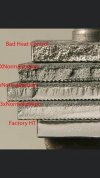A.McPherson
Knifemaker / Craftsman / Service Provider
- Joined
- Jan 27, 2012
- Messages
- 2,894
Hey, bummer your knife broke!
Here's something to think about too, when using recycled steel. That steel was taken out of service for a reason. That crack could have been there when you started forging, maybe as a micro-fracture that you couldn't see.
Then as you forged the blade that crack propagated to the point that when you tapped it, it gave up the ghost.
Of course there's no way to prove where it went wrong but at least you got some forging practice out of it!!
Here's something to think about too, when using recycled steel. That steel was taken out of service for a reason. That crack could have been there when you started forging, maybe as a micro-fracture that you couldn't see.
Then as you forged the blade that crack propagated to the point that when you tapped it, it gave up the ghost.
Of course there's no way to prove where it went wrong but at least you got some forging practice out of it!!









